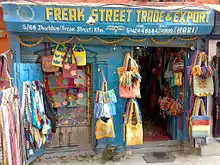Old Freak Street
Jhochhen Tole (Nepali: झोछेँ टोल, romanized: Jhochhen Tole), popularly known as Old Freak Street, or Freak Street is a small neighbourhood located at the south of Kathmandu Durbar Square.
| Freak Street | |
 Freak Street in 1973 | |
| Native name | |
|---|---|
| Location | South of Kathmandu Durbar Square, Nepal |
| Coordinates | 27.7033°N 85.3075°E |
| Other | |
| Known for | Popular destination on 1960s/1970s hippie trail, drug selling |
Presently known as Old Freak Street, this ancient street was named Freak Street, referring to the hippie trail of the 1960s and 1970s.
History
Freak Street was a center in the years of the hippie trail from the early 1960s to late 1970s. The main attraction drawing tourists to Freak Street was then the government-run hashish shops. Hippies from different parts of the world traveled to Freak Street (Basantapur) in search of legal cannabis. There were also direct bus services to Freak Street from the airport and borders, targeting the hippies looking for legal smokes. Freak Street was a hippie nirvana, since marijuana and hashish were legal and sold openly in government licensed shops.[1] A young restless population in the west, seeking to distance itself from political and social frustration, had firsthand contact with the culture, art and architecture, and lifestyle that attracted them to Freak Street.
In the early 1970s, the government of Nepal started a round-up of hippies on Freak Street and deported them to India, an action propelled largely by a directive from the government of United States of America. The government imposed a strict regulation for tourists regarding dress codes and physical appearances. After imposing such regulations by government the hippies felt vulnerable and the hippie movement of Nepal died out in the late 1970s. It was under this directive that the Nepali government came to ban the production and sale of hashish and marijuana in Nepal.[2] The hippie tourism was quickly replaced with the more conventional businesses of trekking and cultural tourism.

Culture
Old Freak Street's history and prime position in the heart of Kathmandu still make it a popular destination among the locals. It was once labeled as a place to find enlightenment; there have been many changes since the deportation of the hippies in the early 1970s.[3] The street was named as Freak Street, after the hippies; its name is now Old Freak Street: it is no longer as it was back in the 1960s.[4] This place is now just a mythical magnet for hippies and other social variants of the 1960s. Guest houses, trekking agencies, shopping centers, souvenir shops, restaurants are the businesses the local entrepreneurs have adopted after the banning of cannabis in Nepal.[5] Overshadowed by the glamour of Thamel, a primary tourist area in Kathmandu, Old Freak Street has not been able to revive its charm for tourists since then.[6]
References
- Pietri, Joseph. "Golden Tar Heroin and the Black Prince: The Drug Trail Ends in Kathmandu". kingofnepal.net/. Retrieved 22 April 2013.
- Adhikari,Bashyal, Ankit,Pradeep (2011-10-01). "Remembering Freak Street". ekantipur. Archived from the original on 30 September 2012. Retrieved 22 April 2013.
{{cite news}}: CS1 maint: multiple names: authors list (link) - DURAND, AMELIE. "What happened to the hippie trail". area148.com. Retrieved 22 April 2013.
- "Jhochhen(Old Freek Street)". freakstreetnepal.com/. Retrieved 22 April 2013.
- "Freak Street". lonelyplanet.com/. Retrieved 22 April 2013.
- Ruiter, Andrées de. "Freak Street in Kathmandu". nepal-dia.de/. Retrieved 22 April 2013.